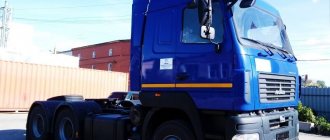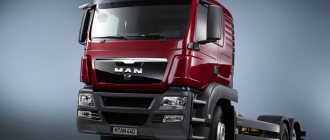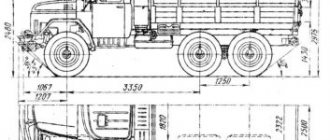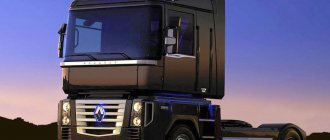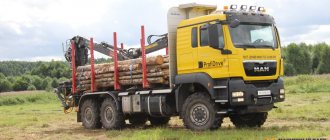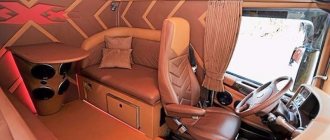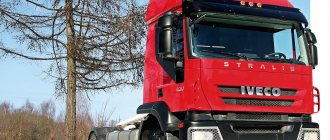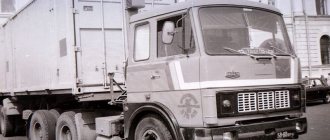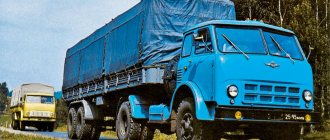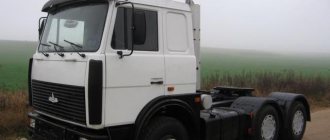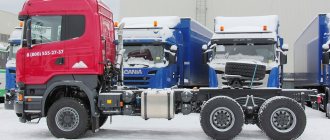Iveco-AMT. 20th anniversary
–Vladimir Leonidovich, what was the enterprise like when you took over its helm?
– The joint venture created on a parity basis by Iveco SpA, Gazprom and the Ural Automobile Plant, which was then called IVECO-URALAZ, was officially registered on December 5, 1994. Almost simultaneously with this event that happened 20 years ago, my career in the joint venture began: being in the position of deputy chief designer of URALAZ, I headed a group that trained in Germany and, together with specialists from Iveco, developed the UralTrakker specifically for IVECO-URALAZ.
| General Director of Iveco-AMT LLC Vladimir Novik |
I assumed the position of director of the joint venture on July 8, 1998. I remember that at that time there were only seven thousand rubles in the joint venture’s accounts, but there was a million dollar debt in foreign currency. What can I say: we didn’t even have our own production building, which appeared only in 2000. At the same time, we made an important, one might say, strategic decision, which subsequently played a decisive role in the success of the enterprise: we began to actively move from the production of serial models to the development and production of technological vehicles in accordance with the individual requirements and wishes of customers. In 2004, the plant launched the production of trailed equipment, in 2006 - the production of dumping platforms, in 2007 - the production of four-axle chassis with a rear rolling axle, and in 2009 - the production of log platforms and fire trucks. After the actual withdrawal of Ural Auto from the founders, IVECO-URALAZ changed its name to Iveco-AMT in May 2008, after which we, despite the severe financial crisis that gripped the country, began to actively increase our capacity: if at the end of 2000- x IVECO-AMT production area occupied 7.5 thousand square meters. m, then today it is almost 30.4 thousand square meters. m, and our territory has grown five times!
Of course, you can’t tell much about our path over the past 20 years in a nutshell, so I’ll just note that during this time the plant several times found itself in situations where many were ready to write it off, but time after time we overcame all difficulties, becoming stronger, gaining invaluable experience and new customers.
– What is the secret that Iveco-AMT continues to operate confidently even after 20 years, unlike other joint ventures created in the 1990s in the automotive industry?
– There are several fundamental reasons for this.
Firstly, Iveco-AMT does not depend on anyone except its customers. That is, how much they sold, how much they earned. We have no one to rely on, which means we rely only on ourselves.
Secondly, we do not allow anyone to control our future, therefore, regardless of the circumstances, we steadily move towards our goals.
Thirdly, we clearly understand that the well-being of an enterprise is based solely on our own product, developed by our designers and technologists.
Fourthly, we have always strived to create a full-fledged automobile plant. And today I can say with confidence that this goal has been achieved.
– That is, the Iveco-AMT production site located in Miass has acquired a completed look?
- Almost completed. Thanks to investments made since 2007 of more than a billion dollars, in 2010 we built a new assembly building from scratch, and this year we commissioned a painting and cabin assembly building, purchasing the most modern equipment to equip them. All this increased the capabilities of Iveco-AMT several times. In the future, there is construction of a robotic welding shop, but even without this, in general, the plan to expand and improve the production capacity of the enterprise has been completed.
– Is the suspension of investments related to the crisis situation in which the country’s economy finds itself?
- Partly. But still, the main reason is the lack of stability in the economic policy pursued by the state. Literally every new government initiative that affects the cost of vehicles forces us to rewrite the annual plan downward. Not only has the recycling fee been extended to cars produced in the country, but import customs duties are also being reduced: if last year they were 25% for heavy trucks, this year they decreased first to 10%, then to 8.5%, and soon it will be 6%. Here we must take into account that changes in duties affect Iveco-AMT more strongly than enterprises in the traditional automobile industry, unlike which we directly compete with European manufacturers on price. Therefore, every percentage point by which import duties are reduced seriously undermines our competitive advantages.
– In the context of a shrinking market, will the company expand or, conversely, narrow the line of equipment produced? In particular, will the issue of assembling the Iveco Daily model be resolved positively?
– As for Iveco Daily, we have been approached more than once with a similar proposal, but Iveco-AMT will not produce this car at home. Because it does not fit into the technological chain built at the enterprise. To organize the production of Daily, we would have to, in fact, build a separate plant, and this is a huge investment that in the current conditions will not pay off.
Now for the rest of the line. Let me remind you that over the past five years, Iveco-AMT, in addition to the Trakker family, has mastered the production of Stralis and Eurocargo at its facilities. So, the release of the first has been suspended, and the release of the second is in the process of optimization - we will continue to promote Eurocargo primarily in the 4x4 version, as well as in independently developed 6x4 and 6x6 versions. On the other hand, “Iveco-AMT will continue to expand the Trakker family with a 6x6 wheel arrangement - it is with such vehicles that the successful work of the enterprise has been associated in recent years. In particular, in the near future, on the basis of the lightweight two-axle Trakker model existing in Europe, we will create a three-axle all-wheel drive vehicle - unlike the three-axle Eurocargo, its total weight can be increased to the 26 tons demanded by many customers.
And special emphasis will be placed on the creation and development of a line of CNG cars, that is, those powered by methane: the city has begun producing gas Eurocargos, which, being manufactured at Iveco-AMT, are considered Russian cars and can participate in government procurement, and we will offer gas to our traditional customers Trakker: the Italians do not have a CNG engine specifically for this model, but we will - the car will go into production in January.
– In recent years, a lot has been said about the gasification of vehicles, but little has been done. Is it possible that customers still have such a high interest in such equipment that you are ready to invest in the development of a gas modification of the engine for Iveco Trakker?
– Interest has not only remained, it has even grown. Understanding the benefits of switching to gas appears when you begin to convince customers with the help of numbers. Let's do the math. First, let’s take as an example the operation of an Iveco Stralis truck in St. Petersburg with its quite average Russian price for diesel fuel of 32 rubles/l and a slightly inflated price for methane of 15 rubles/m3, which we multiply by a factor of 1.2 - this is the ratio of consumption of a cubic meter of gas to consumption of a liter of diesel fuel. The difference in cost between the two types of fuel is 14 rubles. per unit volume. During the year, Stralis, consuming an average of 30 l/100 km, covers about 200 thousand km. As a result of simple arithmetic operations, we find that the gas modification of Iveco Stralis will save the owner 840 thousand rubles in a year. At the same time, it is 800 thousand rubles more expensive than the diesel version, that is, the payback will occur in less than 12 months!
Now let’s imagine that we don’t have a mainline Stralis, but a Trakker log carrier, and it operates not in St. Petersburg, but in the north or in the Far East, where diesel fuel already costs 38 rubles/l, and methane at gas stations, on the contrary, is cheaper and sold at a price of 10 rubles/m3. We calculate again and find that the annual savings from one gasified car will grow to almost 4.7 million rubles. Agree, there is something to think about!
– How does the new Trakker produced in Miass differ from the same model supplied from Europe?
– I’ll say right away that from this year the agreement concluded between us and Iveco came into effect, according to which all Iveco Trakker with a 6x6 wheel arrangement supplied to Russian customers will be manufactured by our enterprise, so that their import from Europe is no longer expected.
As for the differences in the design of ours and the European Iveco Trakker, we are ready to offer these cars not only with the “Iveco” front drive axle and transfer case, but also with their analogues from other manufacturers. Thus, the front axle of the Trakker manufactured in Miass can now also be a Kessler or RABA, an alternative to the Ivekov transfer case is a ZF transfer case, and the current ZF gearbox will be replaced by an analogue of the same brand, but of a different model, or an “automatic” Allison. I want to assure all our existing and future customers: we will not allow a decline in the quality and reliability of Trakker vehicles, because all the past, present and future successes of Iveco-AMT are connected with them.
– What was the main task facing the company this year, taking into account the latest economic crisis that began in the country?
– The main task was not to fall below a thousand trucks produced, which turned out to be difficult. For the first six months, there was virtually no demand for one of our main models, a 6x6 dump truck. Due to the difficult economic situation, traditional customers from the logging industry did not conclude large contracts. However, expanding the capabilities of Iveco-AMT to improve the designs of technological vehicles for a variety of industries, increasing flexibility in creating their various modifications and configurations did their job - a sharp decline in production was avoided.
– Is it possible to speak confidently about the future of Iveco-AMT in the context of the current economic downturn, which has no end in sight?
– I agree that the decline in the market for heavy commercial equipment is very noticeable for the enterprise and tomorrow the situation in the country’s economy is unlikely to improve dramatically. However, at present, Iveco-AMT has its own unique product that is in demand by the market, has its own modern well-equipped plant, has a strong professional team and has a name that has earned trust and respect. So, having successfully overcome a series of various difficulties and mistakes over the past 20 years, today we stand firmly on our feet and look into the future with confidence!
Iveco-AMT 733910
Especially for September, Iveco-AMT manufactured nine truck tractors with an 8x8 wheel arrangement, designed to work as part of a road train with a gross weight of up to 130 tons. The base for them was a standard all-wheel drive four-axle Iveco Trakker AT410T45W with a 450-horsepower Cursor 13 and 16 diesel engine. -speed gearbox of the ZF brand. But Iveco-AMT specialists, in fact, turned it into a new model: they replaced the short cab with an extended sleeper one, installed larger wheels (16R20 tires), and made appropriate modifications to the suspension. The curb weight of the tractor is 13,650 kg, the permissible load on the 3.5-inch fifth wheel coupling is 30,000 kg, its height is 1750 mm.
Iveco-AMT 453911
Iveco-AMT designers, using components from the two-axle Iveco Eurocargo ML230E28, independently developed a chassis with a 6x4 wheel arrangement, several prototypes of which were equipped with a rear-unloading 9-cc dump truck of their own production. The car is equipped with a 5.9-liter Iveco Tector diesel engine with a power of 279 hp, which is coupled with a manual 9-speed gearbox or, as an option, an Allison 3000 automatic transmission. The front axle is from Iveco Eurocargo with disc brakes, and the rear axle axles - RABA with drum brakes. Tires – 385/65R22.5.
With a gross weight of 23,000 kg, the dump truck is designed to transport 12,480 kg of cargo. In the future, a modification with a 12-cc dump body will be developed for low-density cargo.
Iveco-AMT 493924
Taking the Iveco Eurocargo ML150E28W as a basis, Iveco-AMT specialists created a three-axle off-road chassis with all-wheel drive and single-pitch tires on all wheels (390/95R20 tires). Its prototype was equipped with a 12-cubic-meter suitcase-type fuel tank manufactured with two compartments of equal capacity and a 1SNV-80A dispensing pump. The curb and gross weight of the tanker is 10,220 and 20,495 kg, respectively, and the engine used is a 279-horsepower Iveco Tector. It is paired with a 6-speed ZF gearbox and a 2-speed transfer case. The front axle is borrowed from Iveco Eurocargo, the rear axles are manufactured by RABA. The suspension is completely spring, dependent, all brake mechanisms are drum type.
Iveco-AMT 633910
Especially for its 20th anniversary, Iveco-AMT released a special series of 20 all-wheel drive truck tractors with a high sleeper cabin (two shelves, internal height 2100 mm) in a special configuration and on special purchase conditions. Iveco Trakker AT380T42W was taken as the base for them. The model, with a curb weight of 11,020 kg and designed to work as part of a road train weighing 97,100 kg, is equipped with a Cursor 13 diesel engine with a power of 420 hp, which is coupled with a 16-speed ZF gearbox and a 2-speed ZF transfer case of the VG 2000/ series 300. The front axle is switchable, manufactured by RABA, with a permissible load of 9,000 kg, and the permissible load on the 3.5-inch fifth wheel is 27,000 kg. The tractor is equipped with two fuel tanks (500 and 195 l), dual-pitch rear wheels, tire size 13R22.5.
IVECOIveco-AMTTrakkerIveco-AMTIveco-Uralaz
Tweet
